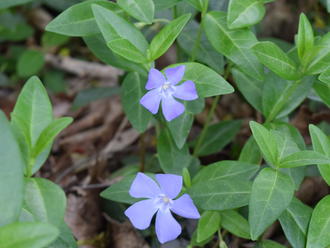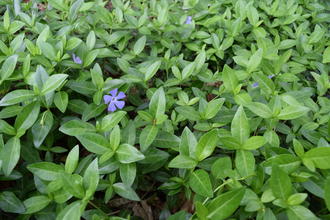Common Periwinkle (Vinca minor L.)
Also known as myrtle, creeping myrtle, lesser periwinkle.
↑Summary
A perennial evergreen plant, native to Europe and widely introduced in North America due to being widely used as a landscaping plant.
↑Range - Expand
| Legend | Color |
| Introduced | |
| Introduced or Not Present |
This tentative map is based on our own research. It may have limited data on Canada and/or Mexico, and there is some subjectivity in our assignment of plants as introduced vs. expanded. Read more in this blog post.
Although this plant occurs somewhere in each of these regions, it may only occur in a small part of some or all of them.
↑Life Cycle
This plant is a creeping perennial that tends to form large mats and colonies which can persist for years. In North America, this plant reproduces primarily vegetatively, rarely reproducing by seeds.
Spreads both by underground runners and above-ground stems that root at the nodes.
Foliage is evergreen. New growth is produced profusely in the spring and continues as long as conditions are favorable.
Able to regenerate from small pieces of root. Colonies often form multi-layer mats from combination of surface stems rooting at nodes, and deeper rhizomes, making this plant difficult to remove and able to quickly bounce back from natural disturbances as well.
↑Uses
This plant is widely planted as a landscaping plant, where it is valued for its attractive flowers, being an evergreen groundcover, and surviving under a wide range of conditions from sun to shade, wet to dry.
Its use is decreasing because of the difficulty of removing it and its propensity to invade wild areas adjacent to gardens, often spreading vegetatively through large swaths of forest where it shuts out other vegetation.
↑Related Plants
There are two other Vinca species in North America, both introduced. The closely-related Vinca major is widely established, but somewhat less than this one. Vinca herbacea has also become established in Massachussets. Vinca major has larger leaves and is slightly less cold-tolerant, but more tolerant of hot and dry weather, and thus becomes more common in the south and southwest of North America.
The broader Apocynaceae family contains many native plants, including dogbanes and milkweeds.
↑Links & External Resources
• Vinca minor (Lesser Periwinkle) | Illinois Wildflowers (About This Site)
• Vinca minor (Common Periwinkle) | USDA PLANTS Database (About This Site)
• Vinca minor | Go Botany (About This Site)
• Lesser Periwinkle | iNaturalist (About This Site)
• Vinca minor (Common Periwinkle) | Missouri Botanical Garden Plant Finder (About This Site)
• Periwinkle | Virginia Tech Dendrology Factsheets (About This Site)
• Vinca minor | Biota of North America Project (BONAP) (About This Site)
• Vinca minor | NatureServe Explorer (About This Site)
• Vinca minor | Missouri Plants (About This Site)
• Common Periwinkle | Maryland Biodiversity Project (About This Site)
• Vinca minor (Periwinkle) | Minnesota Wildflowers (About This Site)
• Vinca minor L. (Periwinkle, Common Periwinkle) | Digital Atlas of the Virginia Flora (About This Site)




